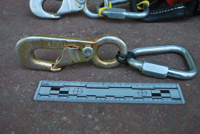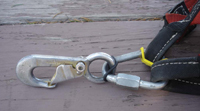
Features
Structural
Training
Trainer’s Corner: September 2010
As I write this on a much-appreciated break between wildfires, there are just under 400 wildfires burning in British Columbia. This has turned out to be one of the province’s busiest fire seasons since 2003.
September 17, 2010
By Ed Brouwer
As I write this on a much-appreciated break between wildfires, there are just under 400 wildfires burning in British Columbia. This has turned out to be one of the province’s busiest fire seasons since 2003.
Unfortunately, this fire season has something else in common with the year B.C. burned. There were three LODDs in 2003 – pilot Ian Mackay, 41; co-pilot Eric Ebert, 32; and helicopter pilot Ben Von Hadenberg, 33.
Now, we just lost two of our firefighters: pilot Tim Whiting, 58, of Langley, and co-pilot Brian Tilley, 36, of Edmonton, died when their Kamloops-based Convair CV 580 airtanker crashed while battling a fire near Lytton.
 |
|
| Marovich’s improper J-hook connection. |
|
 |
|
| Proper J-hook connection. Advertisement
|
This column wasn’t meant to be centred on firefighter fatalities, however. I had planned to inform you about Thomas David Marovich, Jr., a firefighter with the Chester helitack crew attached to the Lassen National Forest. On July 21, 2009, Marovich, a rappeller, sustained fatal injuries from a descent during a proficiency rappel.
Rappelling is a fast and efficient way of getting to fires in remote areas. Firefighters rappel from helicopters hovering up to 76 metres (250 feet) above the ground. Fires are typically caused by lightning, are small in size and require between two and four people one to two days to suppress. Rappellers remain on the fire until it is declared out and routinely pack out with gear weighing 36 to 49 kilograms (80 to 110 pounds) to the nearest pickup point.
According to a July 2009 report by the United States Department of Agriculture Forest Service (available at www.wildfirelessons.net/documents/Willow_CA_Final_2009.pdf), at approximately 0955, in preparation for boarding the helicopter, a buddy check of equipment was performed by rappeller No. 4 (R-4). Marovich was informed of a broken Kong clip on his tri-link that was used to centre the Bourdon J-hook at the forward corner of the tri-link. Marovich went to a member of the crew, a spotter trainee, to correct the problem. The spotter trainee opened the tri-link with Leatherman pliers to replace the broken clip with a rubber O-ring that was an authorized substitution. After the replacement, Marovich closed the tri-link barrel by hand and the spotter trainee ensured that the closure nut was tight.
Witnesses said that Marovich then ran back to the helicopter that was in the process of starting. When he arrived at the helicopter, he received a buddy check again from R-4 and a spotter check prior to entering the helicopter.
The helicopter departed at 1004 with pilot, rappel spotter and four rappellers. The helicopter performed a high hover check prior to entering the rappel site and established a 67.5 metre to 75 metre hover over the rappel site. The helicopter was observed to be in a stable hover, with only a minor descent in altitude (estimated less than three metres).
At this time, the spotter initiated the rappel sequence and the ropes were thrown from the aircraft and configured with two Genies on each rope. The spotter gave R-1 a signal to hook up and lock off. R-1 performed the hookup and lock off to the lower of the two Genies. R-1 then presented his Genie to the spotter and the spotter visually inspected the hookup and Genie. The spotter then signalled for R-1 to move to the skid. R-1 stepped out onto the right skid and prepared for his descent, waiting for the opposite rappeller to get into position. The spotter then gave Marovich the signal to hook up and lock off. Marovich performed his hookup, locked off to the lower of the two Genies, and presented his Genie to the spotter.
Marovich then moved out to the left skid, holding onto the figure 8 (a metal descent device used to deploy cargo) with his right hand as he exited the helicopter after letting go of the ring, Marovich disappeared from the skid and witnesses onboard felt a slight bump through the ship.
Witnesses at the heli-base observed an uncharacteristic movement from Marovich as he began to position on the skid, and then almost immediately leaving the skid and entering an excessively fast descent with a few witnesses observing white smoke coming from the rope and his feet “pedaling”. The height of the fall is estimated to have been 67.5 metres.
Response by helitack crews on the ground and emergency medical personnel was immediate but attempts to stabilize Marovich were unsuccessful. Rappeller Marovich was declared deceased about 30 minutes after the event.
This was a horrible accident and one that was completely preventable. The investigation report revealed that the J-hook was not properly placed within the closed tri-link when an equipment replacement was made prior to boarding the helicopter. The initial equipment checks by Marovich and a spotter trainee after modification of equipment, and redundant equipment checks outlined in the helicopter rappel guide that were performed by another rappeller and the spotter, failed to expose the improper rigging of the J-hook and tri-link.
The bottom line is that the J-hook was inspected five times by four different individuals, yet no one noticed the improperly placed O-ring.
The investigative report stated that a misconfigured harness is a very rare event. Research in visual attention has revealed several ways that people don’t see what is in their visual field.
Inattentional blindness is the looked-but-failed-to-see effect. It happens when attention is focused on one aspect of a scene and overlooks an object that is prominent in the visual field and is well above sensory threshold.
Inattentional blindness has been implicated as a common cause of traffic ac-cidents. I wonder how many times this has happened at a fire scene?
Continual size up is of the utmost importance for firefighter safety. What if the safety officer or IC suffers from inattentional blindness or change blindness?
Change blindness is a failure to notice that something is different from what it was. Large changes to a visual scene are very likely to go unnoticed if they occur during saccades (eye movements) because visual analysis is suppressed during that time. Changes may even go unnoticed if subjects are visually tracking the object at the moment of change (Triesch et al. 2003).
The best way to understand this is to watch the Test Your Awareness clip found on YouTube. This clip can be downloaded and shown at your next practice. Your members will be surprised.
This brings us to confirmation bias, the tendency to search for or interpret information in a way that confirms our preconceptions/expectations and to ignore, not look for, or undervalue, what contradicts our preconceptions.
A repeated review of an established condition (for example, a correctly configured harness) reinforces the expectation that the system is in that specific configuration. This is an example of reinforcement through experience, which leads one to miss potentially critical anomalies. The existence of inattention and change blindness, as well as the influence of expectations on vision (confirmation bias), helps us make sense of this tragic event.
How many times do we do a buddy check especially before entering IDLH environments? How often does the colour of smoke change without the IC taking note?
Recently we were fighting a wildfire roughly 270 metres away from the pump (Mark III) and about 70 metres in elevation above the bladder. After laying out the hose line we called for water and the pump operator started the pump. Seven firefighters on the line could hear the pump running, five expected water, but two of us knew by the sound that the pump had lost its prime and no water would be coming. We all hear and see but we do not all hear and see the same thing. Confirmation bias would have influenced us to believe the report of the five – that water was on the way.
Until next time stay safe, and train like their lives depend on it.
In memory of Tim Whiting, Brian Tilley and Thomas David Marovich, Jr. Rest in peace, brothers.
Print this page